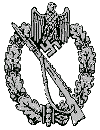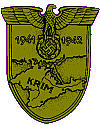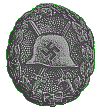Service and Long Service Awards |
Wehrmacht
Long Service Award
(Wehrmacht Dienstauszeichen) Instituted: 14 March 1936
Requirements: Service in the armed forces for a specified period of time.
Awarded in several grades, for 4, 12, 18, 25 and 40 years of service; only the two
most recent awards could be worn concurrently.
Rarity: The 4 year award may have been fairly common, but the small size
of the German armed forces in the 1930s would have resulted in the 12 and 18 year grades
being much more rare, and those posessing them would probably have been too old to be
serving as frontline soldiers. |
 While issued in the form of a medal and ribbon, only the ribbon was worn on the
uniform when in the field, on the ribbon bar (only) over the left breast.. The Army
and the Luftwaffe had their own distinctive national insignia pinned to the ribbon. |
War
Merit Cross Second Class
(Kriegsverdienstkreuz II Klasse) Instituted: 18 October 1939
Requirements: Awarded to civilians and military personnel for outstanding
service in furtherance of the war effort, in particular bravery or service not connected
with direct military combat. Awarded with swords for bravery not connected to front
line action and without swords for meritorious service. Until 21 September 1941,
anyone holding the EK II was ineligible for this award, but Hitler personally changed this
restriction on that date. The War Merit Cross was thereafter worn with the Iron
Cross, but behind it in order of precedence.
Rarity: On the order of 6,134,000+ awards of the Second Class award with
swords were presented. |
  
While issued in the form of a medal and ribbon, only the ribbon was worn on the uniform
when in the field, either on the ribbon bar or as a buttonhole award. A swords device was
worn on the ribbon when worn in the ribbon bar, but not when the ribbon was worn in the
buttonhole.
|
War
Merit Cross First Class
(Kriegsverdienstkreuz I Klasse) Instituted: 18 October 1939
Requirements: Awarded to civilians and military personnel for outstanding
service in furtherance of the war effort, in particular bravery or service not connected
with direct military combat. Awarded with swords for bravery not connected to front
line action and without swords for meritorious service. The award of the War Merit
Cross 2nd Class was a prerequisite, though on rare occasions both awards were presented
simultaneously. Until 21 September 1941, anyone holding the EK I was ineligible for
this award, but Hitler personally changed this restriction on that date. The War
Merit Cross was thereafter worn with the Iron Cross, but behind it in order of precedence.
Rarity: Over 483,000 awards of the First Class award with Swords were
made. 91,239 of the First Class without Swords were awarded. |
 |
Always worn centred on the left breast
pocket, unless the EK I was also worn, in which case the EK I would normally be centred
and the War Merit Cross either beside or below it. |
 |
| Without Swords |
With
Swords |
|
Knight's
Cross of the War Merit Cross
(Ritterkreuz zum Kriegsverdienstkreuz) Instituted: 19 August 1940
Requirements: The cross without swords was introduced to recognize
outstanding achievements by the civil population of Germany, the civil service, and
members of the Party. This cross was made of silver and in July 1944, a version of
the cross in gold was created.
Rarity: Only 137 awards without swords in silver, and 12 without swords
in gold, were made. The silver award with swords was bestowed an estimated 118
times, with the gold version with swords being awarded only nine times. |
|
War Service Badges |
| Infantry
Assault Badge (Infanteriesturmabzeichen) Instituted: 20 December
1939 (Silver version) and 1 June 1940 (Bronze version)
First Awarded: April 1940
Requirements: Participation in at least three seperate infantry assaults.
Restrictions: The silver version went to men in Infantry units, the
bronze version to soldiers in Motorized Infantry units. Only one type of assault
badge could be worn, regardless of the number of transfers to other arms.
Rarity: An extremely common award, probably awarded in the millions. |
 
Worn on the left pocket, centred if no other badges were worn, or on
the left side of the EK I (as viewed from the front) when that medal was worn. Only
1 assault badge could be worn at any one time, usually the first one awarded. |
| Armoured
Assault Badge (Panzersturmabzeichen) Instituted: 20 December
1939 (Silver version) and 1 June 1940 (Bronze version)
Requirements: Participation in at least three seperate armoured assaults,
having been wounded in an assault, or having been decorated for bravery during an assault.
Restrictions: The silver version went to tank crews, the bronze version
to crewmen of other armoured vehicles, such as self-propelled guns, panzergrenadier troops
in halftracks, armoured medical personnel, etc. Only one type of assault badge could
be worn, regardless of the number of transfers to other arms.
Rarity: A fairly common award, especially for tank crewmen. |
 
Worn on the left pocket, centred if no other badges were worn, or on
the left side of the EK I (as viewed from the front) when that medal was worn. Only
1 assault badge could be worn at any one time, usually the first one awarded. |
| General
Assault Badge (Allgemeinesturmabzeichen) Instituted: 1 June 1940
Requirements: Participation in at least three seperate assaults, having
been wounded in an assault, or having been decorated for bravery during an assault.
Also awarded for the single-handed destruction of enemy AFVs before the introduction of
the Tank Destruction Badge.
Restrictions: Awarded to those troops not eligible for the Infantry or
Armoured assault badges; especially combat engineers, but also assault gun crews,
anti-aircraft artillerymen, anti-tank gun crews, and even medical personnel.
Rarity: Fairly common award, most commonly associated with Pionier and
assault gun units. |

Worn on the left pocket, centred if no other badges were worn, or on
the left side of the EK I (as viewed from the front) when that medal was worn. Only
1 assault badge could be worn at any one time, usually the first one awarded.
|
Close Combat
Bar (Nähkampfspange)
Instituted: 25 November 1942
First Awarded: Gold version - 27 August 1944
Requirements: Participation in at least 15 days of close combat (10 if
recipient wounded) qualified one for the Bronze award. For service in Russia, credit
was backdated to June 1941 and the Bronze award could thus also be tallied with eight
month's service equalling 5 combat days. Twelve month's service equated with ten
combat days and fifteen month's service with fifteen combat days. The Silver award
required thirty days service (twenty if wounded) and the Gold fifty days (forty if
wounded)
Rarity: Only 403 Gold awards were made. Numbers for the bronze
award don't seem to be in evidence, but the high attrition rate among infantrymen probably
made this a somewhat rare award. In September 1944, it was decreed that bestowal of the Close Combat Bar in
Gold would automatically result in the award of the German Cross in Gold also to the
deserving soldier. |



Worn above the ribbon bar on the left breast.
|
Campaign Awards |
Medal for the
Winter Campaign in the East 1941-1942 (Ostmedaille)
Instituted: 26 May 1942
Requirements: To have served in the Russian theatre of operations, either
for two weeks of combat or for sixty continuous days anywhere in the theatre, or to have
been wounded or frostbitten in the theatre before completing the qualifying time, during
the period 15 November 1941 to 15 April 1942.
Rarity: Several hundred thousand troops would have qualified, though many
troops to whom it would conveivably have gone to became casualties during the first
winter. |
 
While issued in the form of a medal and ribbon, only the ribbon was worn on the uniform
when in the field, either on the ribbon bar or as a buttonhole award.
|
Crimea
Shield (Krimschild)
Instituted: 25 July 1942
Requirements: To have served in the Crimea for three months, to have
taken part in at least one major operation against the enemy, or to have been wounded in
the region before completing the qualifying time, during the period 21 Sep 1941 to 4 Jul
1942.
Rarity: It is estimated that 100,000 shields were awarded. Demjansk Shield (Demjanskschild)
Instituted: 25 Apr 1943
Requirements: To have served for sixty days in the Demjansk garrison, or
to have been wounded or decorated for bravery while a member of the garrison.
Rarity: Approximately 100,000 men served in the garrison, and
approximately the same number of awards of the shield were made
Kuban Shield
(Kubanschild)
Instituted: 21 Sep 1943
Requirements: To have served in the Kuban bridgehead for sixty days, to
have been wounded while serving in the bridgehead, or to have participated in at least one
major operation. |
Worn on the left
sleeve of the field blouse or greatcoat, overtop of rank chevrons where present. In
rare cases where more than one badge was worn, they were worn side by side, a third badge
was worn over the other two. Each badge was backed with an appropriate piece
of uniform cloth (field grey or black as appropriate) |
Crete Cuff
Title(Kreta armelband)
Instituted: 16 October 1942
Requirements: To have been engaged in glider or parachute landings on Crete between 20 and 27
May 1941, or been engaged with the naval flotilla during the operations in May 1941 in
Cretan waters. Afrika
Cuff Title (Afrika armelband)
Instituted: 15 January 1943
Requirements: To have served on North African soil for at least six months; to have been
in combat in the African theatre of operations; to have contracted an illness while
in Africa after being in theatre at least three months; any soldier awarded the Iron Cross
or the German Cross in Gold for actions in theatre received the cuff title automatically.
On 6 May 1943, Hitler personally
reduced the time requirement for this award from six months to four months. |

Worn on the left forearm, 15 cm from the edge of the cuff.

Worn on the left forearm, 15 cm from the edge of the
cuff. This title was a true campaign title. Previous titles (AFRIKAKORPS in
silver on green, and AFRIKA on dark blue) worn by the Army and Luftwaffe as simple unit
identification were being worn unofficially as campaign titles before this title was
instituted.
|
Wounds Badges |
Wounds
Badge (Verwundetenabzeichen)
Instituted: 1 September 1939 (a reissue of a similar badge awarded in WW I)
Requirements: Suffering 1 or 2 wounds entitled a soldier for the Black
Class. Three or fourwounds, or loss of a hand, foot, eye or hearing regardless of
number of wounds, entitled a soldier to the Silver Class, and five wounds or more (or
fewer, resulting in total disability, permanent blindness, or "loss of manhood)
qualified a soldier for the Gold Class.
Rarity: Black and silver class badges were fairly common. |
Worn on the left breast pocket,
either centred on the pocket, or to the side of other awards if present. |
Achievement Awards |
Tank
Destruction Badge (Panzervernichtenabzeichen)
Instituted: 9 March 1942 (Silver) and 18 December 1943 (Gold)
Requirements: One silver badge was granted to any soldier who
single-handedly destroyed an enemy armoured fighting vehicle. Upon earning the fifth
silver badge, the five were exchanged for one gold badge instead, with the 6th, 7th etc.
again being represented by silver badges worn in addition to the gold, until another
multiple of 5 had been earned. The award was backdated to include any
"kills" tallied from 22 June 1941 onwards. The recipient had to knock out
the enemy vehicle with hand-weapons, and not be performing as part of a tank or anti-tank
gun crew.
Rarity: The number of Soviet tanks on the Russian Front invariably led to
heightened opportunities to earn these badges. Very rare individuals were able to
score multiple kills; Oberstleutnant Günter Viezenz of Grenadier Regiment 7 had 21 such
successes and is accepted as having the highest number of Tank Destruction Badge awards. |

Worn on the right sleeve of the field blouse, halfway between the
shoulder seam and the elbow.
|
Bravery, Leadership and Gallantry
Awards |
| Iron Cross
Second Class (Eisernes Kreuz II Klasse (EK II)) Instituted: 1 September
1939 (reissue of a similar medal awarded in WW I as well as earlier conflicts dating back
to 1813)
Requirements: Awarded for outstanding service and/or bravery in the face
of the enemy.
Rarity: A fairly common award, some 4 to 5 million awards were made to
all the armed services during the Second World War. |


While issued in the form of a medal and ribbon, only the ribbon was worn on the uniform
when in the field, either on the ribbon bar or as a buttonhole award.
|
| Iron Cross
First Class (Eisernes Kreuz I Klasse (EK I)) Instituted: 1
September 1939 (reissue of a similar medal awarded in WW I as well as earlier conflicts
dating back to 1813)
Requirements: .Unlike famous gallantry awards from other nations,
the Iron Cross and Knight's Cross could also be awarded for leadership in addition to
individual acts of courage.
Restrictions: While the EK II and EK I were sometimes awarded
concurrently, the EK I was never awarded without the recipient already having the EK II.
Rarity: Estimates vary from 300,000 to 750,000 awards to all the armed
services. |

Always worn centred on the left breast pocket. Other awards, if present, were worn
to the side or below the EK I.
|
Honor
Roll Clasp (Army)
(Ehrenblatt Spange des Heeres)Instituted: 30 January 1944
Requirements: An Honor Roll of the German Army had been instituted in
July 1941, but no tangible sign of being named to this roll was made until the 1944
anniversary of Hitler's ascension to power. The requirements for being named to the
roll included prior award of the Iron Cross First Class, and performing acts of bravery
not as high as the standard for the German Cross in Gold or Knight's Cross.
Rarity: Only 4,556 awards were made between institution and the end of
the war. |
 
The Honor Roll clasp was worn
pinned to the ribbon of the Iron Cross Second Class.
|
| German Cross
in Gold (Deutsches Kreuz in Geld) Instituted: 28
September 1941
Requirements: Awarded for outstanding service and bravery in the face of
the enemy. The German Cross was not a part of the Iron Cross series of
awards, per se, and was while it was usually awarded for deeds that were
determined not quite enough for award of the Knight's Cross but greater than required for
award of the Iron Cross First Class, there were instances in which Knight's Cross winners
were awarded the German Cross.
In September 1944, it was decreed that bestowal of the Close Combat Bar in Gold
would automatically result in the award of the German Cross in Gold also to the deserving
soldier.
Rarity: Approximately 14,637 went to men of the Army, with 14,000 more
going to other recipients including Waffen SS, Navy and Air Force personnel of all
branches. |

Worn centred on the right breast pocket.
|
| Knights Cross
of the Iron Cross (Ritterkreuz des Eisernen Kreuz) Instituted:
September 1939
Requirements: Unlike famous gallantry awards from other nations,
the Iron Cross and Knight's Cross could also be awarded for leadership rather than
individual acts of courage.
Restrictions: Only awarded to those already holding the EK I.
Rarity: Some 7361 awards were made, with 4777 going to the Army (65%) and 438 (6%) to the Waffen SS. In the Army, they were most
commonly awarded to company-grade officers, with 932 going to men ranked Hauptmann, and
630 to men ranked Oberleutnant, as opposed to just 6 to private soldiers
(Schützen/equivalent). Viewed another way, company grade officers (Leutnant,
Oberleutnant, Hauptmann) received 1976 (41 percent of the Army's total), while NCOs
(Unteroffizier through Stabsfeldwebel, including officer candidates) received 961 (20
percent) and men (all ranks below Unteroffizier) received 223 (4 percent).
Of some 13 million
soldiers in the Army, 1 in 2721 received a Knight's Cross. That figure was 1 in 2283
for the 1 million man Waffen SS. |

Worn suspended around the neck with the ribbon concealed by the shirt or tunic collar and
exposed at the neck.
|
| Oakleaves
to the Knights Cross of the Iron Cross (Eichenlaub zum Ritterkreuz des Eisernen Kreuz)
Instituted:
3 June 1940
Requirements: Unlike famous gallantry awards from other nations,
the Iron Cross and Knight's Cross could also be awarded for leadership rather than
individual acts of courage.
Restrictions: Only awarded to those already holding the Ritterkreuz.
Rarity: Exactly 883 awards were made to all branches of the armed
forces. 583 went to the Army and Waffen SS, 246 went to the Luftwaffe (all
branches). Of the Army awards, only 56 went to men below the rank of
Hauptmann, the lowest ranking of whom was an Unteroffizier. 74 in total went to the
Waffen SS, with only 5 going to men below the rank of Hauptmann/Hauptscharführer, and all
of these went to junior officers - none to NCO's or men. |

Attached directly to the ribbon of the Knight's Cross of the Iron Cross.
|









































